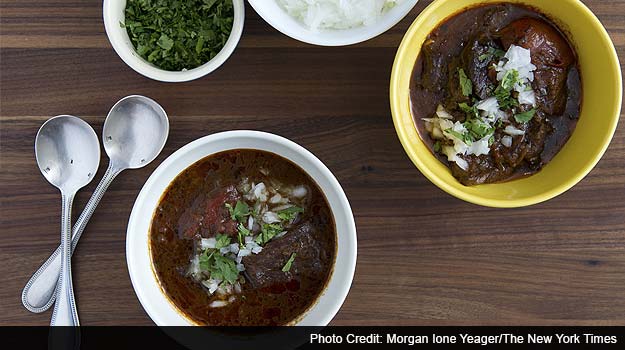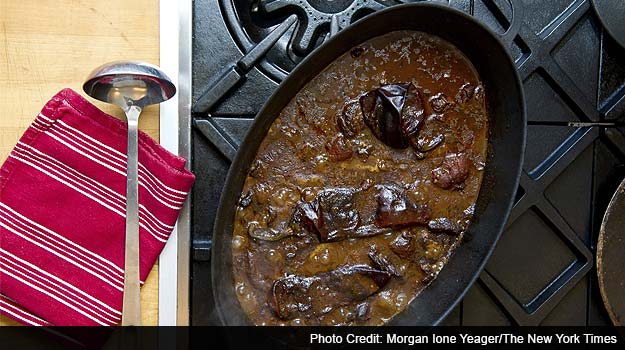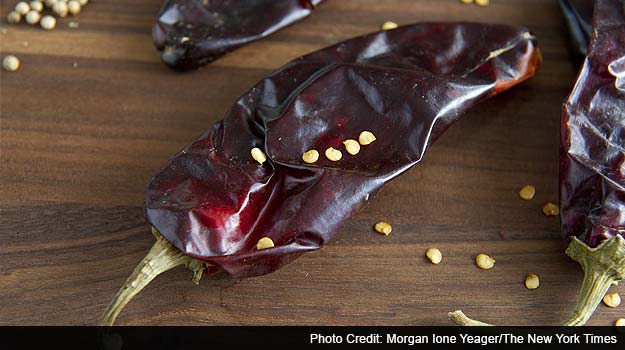If you like to make chili and don't live in Texas, consider yourself lucky. Passions run high in that state over pressing issues like what brand of canned tomatoes to use (if any), how much cumin is too much and whether browning the meat is authentic. Don't get them started on garnishes.
It is liberating to note that chili was in no way invented by Texans, so they do not have a lock on authenticity. That said, there is a certain alchemical balance to great Texas chili, which, like all great beef stews, combines the fragrant spices of a tagine, the succulent beefiness of pot roast and the slurpy heat of a goulash.
This recipe, handed to me by a native of Austin and refined over decades, is ideal for potlucks, Super Bowl parties and stormy days. It includes at least four incarnations of chili and can be customized - not only for heat but for taste, as some cooks prefer the tanginess of guajillo chili to the raisin notes of ancho. The beer, chocolate and masa harina add to the depth of the sauce, but in these quantities, they don't push their own flavors forward.
Chili at its most basic is a stew of protein and chilies. The Aztecs were making it long before the 16th century, when the Spanish friar Bernardino de Sahagun recorded the offerings at urban markets in his book "Historia General de las Cosas de la Nueva Espana": chili made with lobster, fish, frogs and dozens of varieties of green, red, yellow, pickled, smoked and dried chilies.

Later, but long before Texas statehood, Nueva Espana embraced all of the American Southwest and most of Central America. The cowboys who worked the Spanish-owned cattle ranches near the Rio Grande spent months away from home in the dry borderlands, living mostly on tough longhorn meat, water and as many dried chilies as it took to make the meat palatable.
This dish, called carne con chili or carne con chili colorado (colorado meaning red, specifically the dark russet of dried chilies), is the immediate ancestor of Texas chili. It is alive and well in Mexico, where most regions have a version of it. In centuries past, and in many places today, it is made with carne seca, musky, smoky air-dried beef that softens in water and absorbs the heat and sweetness of the chilies. But most home cooks now make it with fresh meat, cut in large chunks or wide slices.

Maria Contreras Rico, who is 80 years old, has a cooking channel on YouTube devoted to the classic home cooking of Mexico. Her carne con chili would probably never get past the first round at any of the dozens of U.S. chili cook-offs: just a nub of garlic; no onions or spices; and many, many chilies Japones, the tiny, fiery pods that she combines with mild chilies California (dried Anaheims) for their rich, aged flavor.
Although Contreras doesn't speak English on screen, her recipes are clear from her deliberate motions and detailed instructions. They are also affectionately translated by her granddaughter Silvia Salas-Sanchez, who began shooting video of her grandmother cooking when she realized, she said, that "these dishes are going to be lost if someone doesn't record them." (At first, like many food-obsessed grandchildren before her, she tried watching, measuring and writing down her grandmother's recipes as she cooked, but she said it was too irritating to both of them.)
Both women live in Southern California, although Contreras grew up in Michoacan and lived in Tijuana for many years, where she became an expert in northern Mexican staples like flour tortillas and refried beans, which complete her plate of carne con chili. (The dish is soupy, so the tortillas are good for dipping.)
The chili we know best is very different. A big hit of cumin is one of the signatures of Tex-Mex cooking (one that the Mexican-food expert Diana Kennedy considers an abomination) and a must for Texas chili. So is coriander seed, oddly, a spice that is hardly used in Mexican cooking.
"Coriander and cumin came to Texas from the Canary Islands," said Robb Walsh, the food historian who was one of the first to treat Tex-Mex food as its own respectable cuisine, not as a bastardization of Mexican food.
The Spanish crown offered titles and land to residents of the Canary Islands, another Spanish possession off the coast of North Africa, who would uproot their families to settle the area that would become San Antonio. The first families arrived in 1731, bringing recipes rich with spices, herbs and garlic that would become the taproot of Tex-Mex taste.
Texas chili also pulls from a couple of other traditions. Apart from President George W. Bush, there's probably no nonnative who has benefited more from association with the state of Texas than William Gebhardt, a German immigrant in New Braunfels who first successfully marketed chili powder in 1896. Gebhardt's innovation was grinding the local chilies - sun-dried anchos from Mexico - into a fine powder, the way paprika is ground from dried red peppers in Central Europe.
In the large German-settled swath of Texas, goulash - meat stewed with paprika - was a dinner staple that the immigrants brought from home, and often served with a dollop of sour cream. (Gulyas, the original Hungarian name for the stew, means cowboy, showing that the taste for beef with quantities of chilies is not confined to the Americas.)
You do not need any special kind of meat to make great chili. But ground beef, outside of Texas, is not an option. The ground beef sold for chili in Texas is much coarser and chunkier than the U.S. standard. That's why some fine Texas cooks deem ground beef acceptable or even preferable in chili. Anyone can order coarse-ground beef at a butcher shop, but supermarket ground beef produces something closer to a sloppy Joe, not fit for any bowl - certainly not a Super Bowl.
On the subject of garnishes for chili, it is safe only to say that all of them are acceptable and none of them are authentic, with the possible exception of Saltine crackers. I say we let the Texans have them.
Texas-Style Chili
Time: 2 hours
1 tablespoon whole cumin seeds
1 1/2 teaspoons whole coriander seeds
4 pounds beef chuck roast or steak
1 teaspoon salt, more to taste
3 tablespoons vegetable oil, plus extra as needed
1 large yellow or white onion, chopped, plus extra chopped onion for serving
6 large garlic cloves, minced
4 to 7 large fresh green jalapenos (depending on how much heat you like), stemmed, seeded and chopped
3 tablespoons masa harina or 1 corn tortilla, torn into pieces (optional)
2 tablespoons ground pure chili powder, such as pasilla, Chimayo or ancho
1 tablespoon dried oregano
1 (12-ounce) bottle Negra Modelo beer
1 28-ounce can diced tomatoes, or 3 10-ounce cans Ro-Tel canned tomatoes with green chilies
1 ounce unsweetened chocolate
3 whole dried large red chilies, such as New Mexico or guajillo
Chopped fresh cilantro, for serving
Fritos or warmed flour tortillas, for serving
1. In a small heavy skillet, toast cumin and coriander seeds until fragrant. In a mortar and pestle, or in a coffee grinder, grind to a powder and set aside.
2. Meanwhile, roughly cut beef into 2-inch cubes, or slice it against the grain into pieces about 1/4-inch thick by 1 1/2 inches square. Sprinkle with salt.
3. In a large, heavy pot over high heat, heat oil until shimmering. Working in batches to avoid crowding the pan, brown the meat, turning occasionally until crusty. Adjust heat to prevent scorching. As it is cooked, remove the meat to drain on paper towels. Add more oil as needed for browning, but do not clean out the pot.
4. To the empty but crusty pot, add onion, garlic, jalapenos, masa harina or tortilla (if using), chili powder, cumin-coriander powder and oregano. Cook, stirring, until onion has softened, 5 to 10 minutes. Add meat, beer, tomatoes, chocolate, whole dried chilies and 1 quart water. Bring to a gentle simmer, and simmer about 1 1/2 hours, or until meat is fork-tender. Remove the dried chilies. Taste and add salt if necessary.
5. Serve immediately or let cool and refrigerate. The chili tastes best 1 or 2 days after it is made.
6. Reheat over low heat if necessary and serve in bowls, sprinkled with onion and cilantro. Add Fritos for crunch, or dip tortillas into the gravy.
Yield: 12 servings
© 2015 New York Times News Service








